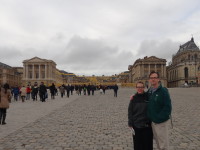 We went to Versailles today. That’s it. A nice, simple day.
We went to Versailles today. That’s it. A nice, simple day.
Ha!
Versailles is mind-blowingly big. Huge. Immense. Gargantuan. There is nothing even close, at least as far as I have seen. We spent over six hours there, from around 10:30 until closing at 5:00, and while we saw all of the highlights of the palace and grounds, we did not come close to seeing it all, and several of the sights were closed because it was off-season or because of renovation.
We took the train out to Versailles, about forty minutes away. We had simple directions (turn right from the station, turn left at the first intersection), but I was commenting that it seemed dumb that there were no signs to the palace; then I looked left at the first intersection, and it was obvious why there were no signs — the place is unmistakable.
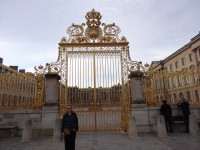 Everywhere you look at Versailles, it is jaw-dropping, awe-inspiring. The palace is huge. The gates and the roof line are gilded. The grounds are vast, varied, and verdant.
Everywhere you look at Versailles, it is jaw-dropping, awe-inspiring. The palace is huge. The gates and the roof line are gilded. The grounds are vast, varied, and verdant.
Even though it was off-season, and there were not mobs of people, there was still a healthy line to get into the palace, so we started with the grounds, which was our plan anyway. We went around to the left side of the house, and there was an impressive garden there. It was formal, and Meredith read from her guidebook that King Louis XIV, who greatly expanded Versailles, had one thousand orange trees growing in greenhouses, and they could be wheeled out and placed around the garden when he wanted orange trees. Then we came around to the back of the house, and I realized that what we had just seen was a garden patch.
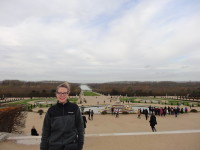 The park at the back of the house lines up with a long view of manicured and fountain-rich lawns. Oh, and there is a mile-long canal that was created so the guests could have actual, imported-from-Italy gondoliers gondola them about on it. You can still rent boats to go out on it today, but not today, since the boats don’t run off-season.
The park at the back of the house lines up with a long view of manicured and fountain-rich lawns. Oh, and there is a mile-long canal that was created so the guests could have actual, imported-from-Italy gondoliers gondola them about on it. You can still rent boats to go out on it today, but not today, since the boats don’t run off-season.
To save some walking, we paid to take a tram out to the far-flung parts of the grounds. Since Louis wanted to escape the pressures of politics in Paris, he expanded Versailles. When that became a nest of politics, he built a smaller, remote palace on the back-forty called the Grand Trianon. We stopped there to tour it. It was much smaller and simpler than the chateau, but still big, and the inside was pretty sumptuous. It was, after all, where the king stayed when he wanted to get away, and it was where his mistress lived (his wife lived in the palace). The Grand Trianon has its own formal grounds and gardens, and according to the guidebook, the gardeners changed out the flowers daily for the king. We did not have time to see the grounds there, since we wanted to spend more time at the Domaine de Marie-Antoinette, the full-scale play peasant village of the wife of Louis XVI.
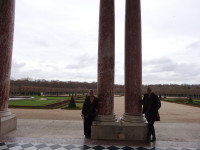 We walked over to the Petit Trianon, the smaller remote palace where Marie-Antoinette lived, to tour that house. It was a little confusing in that the palace did not seem all that luxurious, until we went up to the second floor and realized we must have been down in the servants’ area. The second floor was okay — decked out in finery, with huge windows overlooking more gardens, including a “small” outbuilding where the guests would go to play cards or chat (while listening to live musicians, of course). We had lunch there, about 1:00.
We walked over to the Petit Trianon, the smaller remote palace where Marie-Antoinette lived, to tour that house. It was a little confusing in that the palace did not seem all that luxurious, until we went up to the second floor and realized we must have been down in the servants’ area. The second floor was okay — decked out in finery, with huge windows overlooking more gardens, including a “small” outbuilding where the guests would go to play cards or chat (while listening to live musicians, of course). We had lunch there, about 1:00.
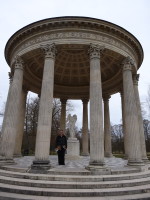 We wandered down to the lake and the Greek-inspired Temple of Love, which all fashionable escape palaces have, before heading down to the play village, following the small man-made river that winds through the grounds. The play village has several buildings, including a lighthouse (what?) and a working farm. Marie-Antoinette had a huge house there, but it was under renovation, and so under wraps (literally — I assume it was covered to protect it from weather during the renovation). The renovation was partly being sponsored by Dior, so to our amusement, on the covering, there were severe, cutting-edge-fashion pictures of models set in formal gardens. It was incongruous.
We wandered down to the lake and the Greek-inspired Temple of Love, which all fashionable escape palaces have, before heading down to the play village, following the small man-made river that winds through the grounds. The play village has several buildings, including a lighthouse (what?) and a working farm. Marie-Antoinette had a huge house there, but it was under renovation, and so under wraps (literally — I assume it was covered to protect it from weather during the renovation). The renovation was partly being sponsored by Dior, so to our amusement, on the covering, there were severe, cutting-edge-fashion pictures of models set in formal gardens. It was incongruous.
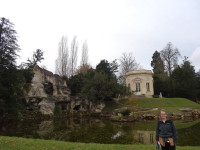 We wandered the village, which was very pretty. None of the buildings were open, and it is certainly possible they never are, but they were definitely closed in November. We kept strolling through the grounds, heading back toward the Petit Trianon, and swung by the artificial grotto and alpine area, where the architect had built a stone waterfall next to a huge gazebo, as one does. That took us back to the Petit Trianon, where we caught the tram over to the Grand Canal, from whence we wanted to walk back up to the chateau.
We wandered the village, which was very pretty. None of the buildings were open, and it is certainly possible they never are, but they were definitely closed in November. We kept strolling through the grounds, heading back toward the Petit Trianon, and swung by the artificial grotto and alpine area, where the architect had built a stone waterfall next to a huge gazebo, as one does. That took us back to the Petit Trianon, where we caught the tram over to the Grand Canal, from whence we wanted to walk back up to the chateau.
The view of the main grounds is always-changing, and it is hard to know when to look up at the house and when to look back at the canal. Both views were spectacular. We ambled over to a Greek-style colonnade off to one side of the grounds, but it was locked off. The off-season has fewer crowds, but fewer sights as well.
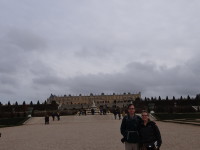 We walked up to the gilded and impressive Latona Basin fountain, which is, like everything else, huge and over the top. That left the touring of the house itself, which we went to, noting with some smugness that there was now no line. In we went.
We walked up to the gilded and impressive Latona Basin fountain, which is, like everything else, huge and over the top. That left the touring of the house itself, which we went to, noting with some smugness that there was now no line. In we went.
We started our tour by walking past the Royal Chapel, where the king would worship (while the nobles faced him!) with the daughters’ apartments, where King Louis’ daughters lived. Each room was sumptuously outfitted, and each had a ridiculously high canopy bed. Mer commented that if the curtains were drawn, it would feel as if you had fallen down a finely-lined elevator shaft.
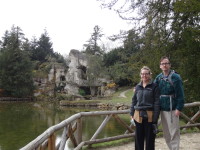 The walk then led us into the king’s quarters, which included a ballroom, a reception area, a throne room, an official bedroom (the king had more than one bedroom), and some other rooms for the king’s use. Each room had a huge mural on it, usually of a Greek or Roman god, since the king styled himself the sun god. These rooms all led to the large Hall of Mirrors, which is still impressive today, with floor-to-ceiling mirrors facing each floor-to-ceiling window, built at a time when mirrors were rare and expensive. Normally, you could tour the queen’s quarters, but they are under renovation at this time, so our tour ended, which worked out okay since it was 5:00 and the place was closing for the evening.
The walk then led us into the king’s quarters, which included a ballroom, a reception area, a throne room, an official bedroom (the king had more than one bedroom), and some other rooms for the king’s use. Each room had a huge mural on it, usually of a Greek or Roman god, since the king styled himself the sun god. These rooms all led to the large Hall of Mirrors, which is still impressive today, with floor-to-ceiling mirrors facing each floor-to-ceiling window, built at a time when mirrors were rare and expensive. Normally, you could tour the queen’s quarters, but they are under renovation at this time, so our tour ended, which worked out okay since it was 5:00 and the place was closing for the evening.
 We walked into town for supper, stopping several times as we went to look back and admire Versailles in the sunset. It is an amazing building, and the town is quite nice too. The bistro at which we ate was very good, and the waiter told Mer that she was the only American he had ever heard speak French. We stopped on the way to the train station to pick up a few pastries for the trip, and we headed home.
We walked into town for supper, stopping several times as we went to look back and admire Versailles in the sunset. It is an amazing building, and the town is quite nice too. The bistro at which we ate was very good, and the waiter told Mer that she was the only American he had ever heard speak French. We stopped on the way to the train station to pick up a few pastries for the trip, and we headed home.
We sneaked in one quick walk down a couple of blocks near our apartment to look at Christmas lights strung along a street. It had the added bonus of allowing us to come across an open store where Mer and I could find chocolate and Dubbs could buy Earl Grey tea.
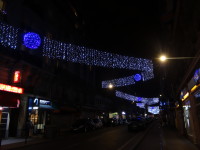 On a funny note, in light of her knee injury, Ami had asked that we not walk as far as we had on Monday, when we went 10 miles (20,300 steps). She forgot to be specific, as we did not walk that much — we walked a fair bit more, putting in 23,500 steps for about 12 miles. We were pretty tired. On the good-news front, Ami’s knee was much better, and she only used the cane for support on rough ground.
On a funny note, in light of her knee injury, Ami had asked that we not walk as far as we had on Monday, when we went 10 miles (20,300 steps). She forgot to be specific, as we did not walk that much — we walked a fair bit more, putting in 23,500 steps for about 12 miles. We were pretty tired. On the good-news front, Ami’s knee was much better, and she only used the cane for support on rough ground.